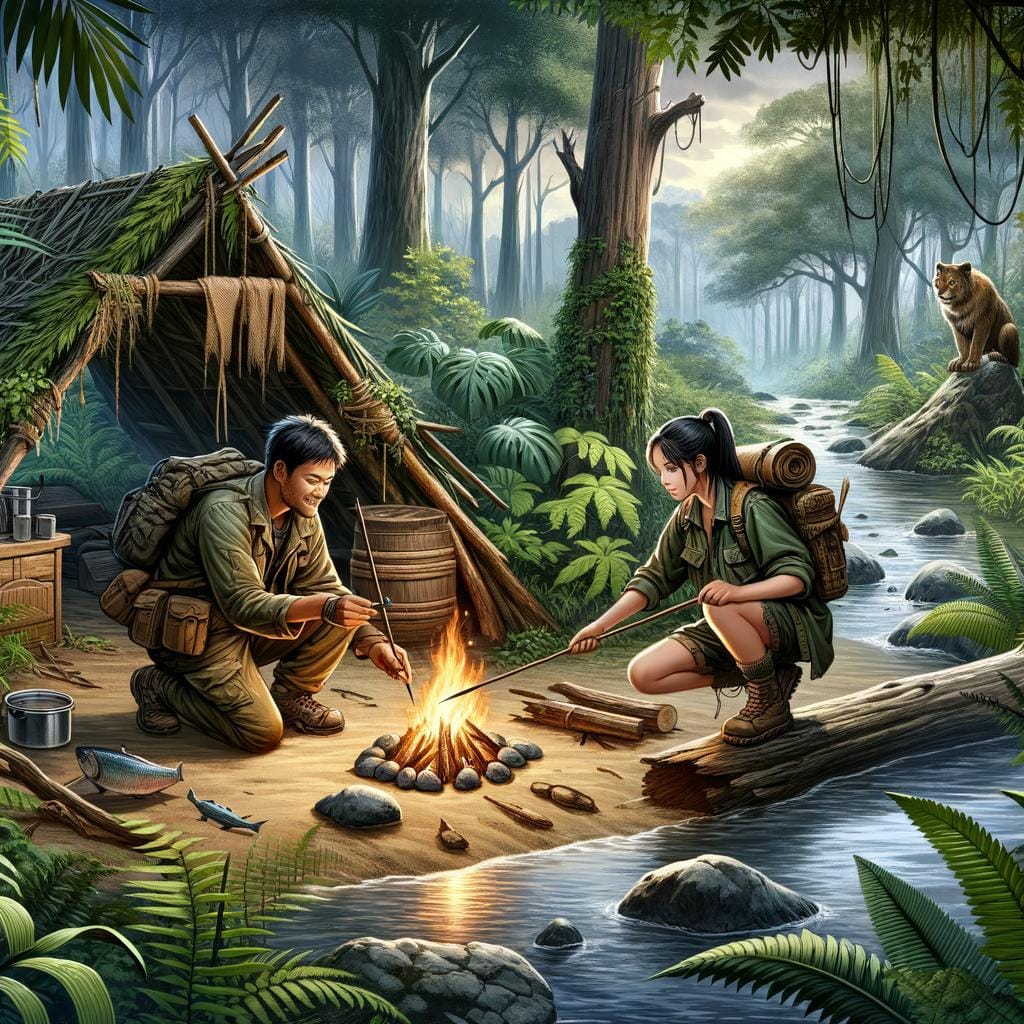Primitive skills have been an integral part of human survival for millennia, dating back to our ancestors who relied on these skills for everyday existence. In this article, we will delve into the fascinating world of primitive skills and their significance in human evolution.
From fire-making techniques to shelter building, edible plant identification to primitive tools and weapons, tracking and trapping to water sourcing and purification – we will explore a wide array of essential skills that have enabled humans to thrive in the wilderness.
The knowledge and mastery of primitive skills have played a crucial role in shaping human history and culture. By understanding the techniques and methods used by our ancestors to survive and thrive in various environments, we gain a deeper appreciation for their resourcefulness and adaptability. These skills not only provide practical tools for survival but also offer insights into the ingenuity and creativity of early humans as they navigated challenging landscapes and climates.
As we embark on this journey of exploration into primitive skills, we will uncover the rich tapestry of knowledge passed down through generations. Whether it’s learning how to create fire from friction or identifying edible plants in the wild, each skill offers a window into our past while equipping us with valuable tools for navigating the present. Join us as we delve into the history, techniques, and importance of primitive skills in human evolution.
The Art of Fire Making
Another popular technique for creating fire in primitive settings is using flint and steel. By striking a piece of flint against a steel striker in just the right way, sparks are produced that can ignite dry tinder. This method is more reliable than friction fire and can be quicker in certain situations. Learning how to properly use flint and steel for fire-making requires some basic knowledge of the materials involved and practice to perfect the technique.
In addition to these traditional methods of creating fire, there are other primitive skills that can be employed for fire-making in survival situations. Knowing how to utilize natural resources like sunlight through a magnifying glass or parabolic mirror to start a fire can be invaluable.
Understanding the principles behind these techniques and practicing them before an emergency situation arises can make all the difference in ensuring your ability to stay warm, cook food, signal for help or keep predators at bay in the wilderness.
| Primitive Skills | Fire Making Techniques |
|---|---|
| Friction fire | The art of starting a fire by rubbing two pieces of wood together |
| Flint and steel | Creating sparks by striking flint against steel to ignite tinder |
| Natural resources | Using sunlight through magnifying glass or parabolic mirror for ignition |
Shelter Building
Understanding the Importance of Shelter Building
In the realm of primitive skills, the ability to build shelters is crucial for survival in the wilderness. Shelter provides protection from the elements, predators, and serves as a safe haven. Understanding different types of primitive shelters and how to construct them using natural materials found in the environment is a valuable skill to have in any survival situation.
Debris Huts: A Time-Tested Shelter
Debris huts are one of the most common types of primitive shelters due to their simplicity and effectiveness. To construct a debris hut, start by creating a framework using sturdy branches and sticks. Then, layer leaves, grass, and other debris on top of the frame to create insulation against wind and rain.
The final step involves covering the entire structure with more debris for added protection. Debris huts are versatile, easily camouflaged, and provide adequate shelter for short-term survival needs.
Lean-Tos and Wickiups: Alternative Shelter Options
For those looking for alternative shelter options, lean-tos and wickiups are worth considering. Lean-tos are simple structures that consist of one sloping roof supported by two or more poles on one end and anchored to the ground on the other. They are quick to build and offer basic protection from rain or snowfall.
On the other hand, wickiups are dome-shaped shelters made by bending flexible saplings into a frame and covering them with layers of bark or hides. Wickiups provide better insulation than lean-tos but require more time and effort to construct. Learning how to build these primitive shelters can enhance your wilderness survival skills significantly.
By mastering the art of building various types of primitive shelters such as debris huts, lean-tos, and wickiups, individuals can gain confidence in their ability to survive in harsh environments using only natural resources and primitive skills. Remember that practice makes perfect when it comes to shelter building, so take every opportunity to hone your skills in constructing these essential structures for survival in the wild.
Edible Plants and Wild Foraging
For those looking to connect with nature and enhance their survival skills, the knowledge of edible plants and wild foraging is essential. In the realm of primitive skills, being able to identify edible plants in the wild can mean the difference between nourishment and starvation. By understanding the various types of wild edible plants, one can supplement their diet with nutrient-rich greens, berries, roots, and more.
Wild foraging requires a keen eye, knowledge of plant identification, and an understanding of seasonal availability. It is crucial to be well-versed in plant characteristics, growth habitats, and potential look-alikes that could be toxic. Foraging responsibly also means only harvesting plants in sustainable amounts to ensure their continued growth in the ecosystem. With practice and patience, individuals can develop a better appreciation for the biodiversity around them as they harvest nature’s bounty safely.
In addition to knowing which wild plants are safe for consumption, it is also important to learn about different ways to prepare them. Some may be best eaten raw while others benefit from cooking or processing methods such as boiling or fermentation. By expanding one’s knowledge on wild edible plants and experimenting with different recipes, individuals can not only survive in the wilderness but also enjoy a diverse array of flavors provided by nature itself.
| Primitive Skills Knowledge | Benefits |
|---|---|
| Wild Edible Plant Identification | Enhances survival skills and provides essential nutrients |
| Foraging Techniques | Promotes a deeper connection with nature and fosters sustainable practices |
| Food Preparation Skills | Diversifies diet options in a wilderness setting |
Primitive Tools and Weapons
When it comes to primitive tools, one of the most versatile and crucial items is the knife. Knives were used by our ancestors for various tasks such as cutting wood, skinning game, and preparing food. In addition to knives, spears were also important tools for hunting and fishing. Spears allowed early humans to take down larger prey from a distance, providing them with a reliable food source.
Another significant primitive weapon that revolutionized hunting and warfare is the bow and arrow. The invention of the bow and arrow allowed humans to hunt more efficiently at greater distances, increasing their chances of success. This weapon also played a vital role in battles between tribes and civilizations, shaping the course of history. Learning how to craft and use these essential primitive tools and weapons is fundamental for anyone looking to hone their primitive skills for survival in challenging environments.
- Knives: Versatile tool for cutting, slicing, carving
- Spears: Used for hunting large game or fishing
- Bow and Arrow: Weapon for hunting at a distance
Tracking and Trapping
Here are some key points to consider when developing tracking and trapping skills in a primitive setting:
- Study animal behavior: Observing the behaviors of various animals in their natural habitat can provide valuable information on their feeding patterns, preferred habitats, and routines.
- Learn to recognize tracks and signs: Identifying tracks, scat, markings, and other signs left by animals can help you track their movements and anticipate their next actions.
- Practice primitive trapping techniques: Utilizing traps such as deadfalls, snares, and pit traps can be effective methods for capturing small game for food or fur.
In addition to tracking skills and primitive trapping techniques, it is important to approach hunting and trapping with respect for wildlife and nature. Sustainable practices ensure that ecosystems remain balanced and healthy for future generations. With a combination of knowledge of animal behavior, adept tracking skills, and proficiency in primitive trapping methods, individuals can enhance their ability to survive in the wild using primitive skills.
Water Sourcing and Purification
Water is essential for survival, and knowing how to find and purify water using primitive methods can be a life-saving skill in the wilderness. In situations where clean water is scarce, it is crucial to have the knowledge and skills to source and purify water safely. By utilizing primitive techniques like solar stills and water filtration, you can ensure that you have access to clean drinking water even in the most rugged environments.
Finding Water Sources
One of the first steps in ensuring your water needs are met in a survival situation is finding a water source. Look for signs of potential water nearby such as vegetation, animal tracks, or low-lying areas where water may collect. Remember that not all water sources are safe to drink from, so always prioritize finding running water like streams or rivers over stagnant sources like ponds or puddles.
Purifying Water With Solar Stills
Solar stills are a simple yet effective way to purify water using the heat of the sun. To create a solar still, dig a hole in the ground and place a container in the center. Place a clear plastic sheet over the hole, securing it with rocks around the edges.
As the sun heats up the ground, moisture will evaporate from the soil and collect on the underside of the plastic sheet, dripping into your container as clean drinking water. This method can help remove impurities and contaminants from questionable water sources.
Water Filtration Techniques
In addition to solar stills, another primitive method for purifying water is through filtration. You can create a makeshift filter using materials like sand, charcoal, rocks, and cloth to remove sediment and particles from dirty water. By layering these materials in a container and allowing gravity to pull the water through them, you can effectively improve its clarity and taste.
While not as thorough as boiling or chemical purification methods, filtration can be an excellent option when fire making resources are limited. Mastering these primitive skills for sourcing and purifying water can be invaluable for anyone venturing into remote locations or preparing for emergency situations where access to clean drinking water may be compromised. Remembering these techniques could mean all difference between life or death when faced with dehydration in challenging circumstances.
Survival Mindset
In conclusion, primitive skills encompass a wide range of knowledge and techniques that have been crucial to human survival throughout history. From mastering the art of fire making to constructing primitive shelters, identifying edible plants, and crafting tools and weapons, these skills are fundamental in navigating the wilderness. However, perhaps equally important is the survival mindset – the mental preparedness, resourcefulness, and adaptability needed to effectively apply these skills in real-life survival situations.
Having a strong survival mindset means being mentally prepared for any challenges that may arise while out in the wild. It requires a keen sense of awareness, quick thinking, and the ability to remain calm under pressure. With the right mindset, individuals can confidently utilize their primitive skills to overcome obstacles and ensure their safety in various outdoor scenarios.
Ultimately, developing a survival mindset goes hand-in-hand with honing primitive skills. By understanding the history and significance of these ancient techniques and embracing the importance of mental preparedness, resourcefulness, and adaptability, individuals can enhance their chances of thriving in the wild. Whether faced with a fire-making challenge or needing to construct a shelter on short notice, those who embody the survival mindset are better equipped to navigate the unpredictable nature of outdoor environments using primitive skills.
Frequently Asked Questions
What Are Primitive Skills?
Primitive skills refer to the basic abilities and knowledge required for survival in a natural environment using only tools and resources available in nature. These skills often involve outdoor activities such as hunting, fishing, shelter building, fire making, and plant identification.
What Are Skills Taught in Primitive Society?
In primitive societies, individuals are taught a wide range of skills essential for survival in their environment. These can include hunting techniques, tracking animals, gathering edible plants, identifying medicinal herbs, creating tools from natural materials, building shelters using local resources, starting fires without matches or lighters, and navigating through unfamiliar terrain without modern technology.
What Is a Primitive Lifestyle?
A primitive lifestyle involves living in harmony with nature and relying on traditional skills passed down through generations for survival. People who adopt a primitive lifestyle often focus on self-sufficiency, sustainability, and minimal impact on the environment.
This way of life may include foraging for food, crafting tools from natural resources like wood and stone, making clothing from animal hides or plant fibers, and constructing shelters using materials found in the surroundings.

An avid outdoor enthusiast, writer, and environmental advocate who has spent over two decades exploring the world’s most breathtaking landscapes. With a background in environmental science and a passion for adventure, Frances combines her love for nature with her talent for storytelling to inspire others to embark on their own outdoor journeys.




